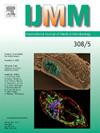肺炎支原体通过glpd介导的氧化驱动巨噬细胞脂质摄取,促进泡沫细胞形成。
IF 3.6
3区 医学
Q1 MICROBIOLOGY
引用次数: 0
摘要
心血管疾病主要由动脉粥样硬化引起,是世界范围内一个主要的公共卫生问题。动脉粥样硬化的特点是动脉壁慢性炎症和脂质积聚,导致斑块形成。在这一过程中,巨噬细胞通过摄取脂质并转化为泡沫细胞发挥关键作用,从而导致斑块不稳定和心血管事件。最近的研究表明,多种病原体参与动脉粥样硬化的发展,肺炎支原体被认为是潜在的候选者之一。因此,本研究采用Raw264.7模型研究该细菌是否诱导巨噬细胞的脂质积累,而巨噬细胞在动脉粥样硬化的发展中起着至关重要的作用。我们的研究结果显示肺炎支原体感染促进巨噬细胞脂滴的形成。细菌中的甘油3-磷酸氧化酶(GlpD)通过产生活性氧参与了这一过程,而活性氧又导致低密度脂蛋白的氧化。此外,参与氧化脂质摄取的氧化脂质受体的表达显著增加表明细菌促进了感染巨噬细胞的脂质摄取。这些结果提示肺炎支原体具有直接的促动脉粥样硬化作用,通过泡沫细胞的形成促进动脉粥样硬化病变的形成。了解肺炎支原体影响动脉粥样硬化的机制为设计预防和管理心血管疾病的新治疗策略提供了有价值的见解。本文章由计算机程序翻译,如有差异,请以英文原文为准。
Mycoplasma pneumoniae drives macrophage lipid uptake via GlpD-mediated oxidation, facilitating foam cell formation
Cardiovascular diseases, primarily caused by atherosclerosis, are a major public health concern worldwide. Atherosclerosis is characterized by chronic inflammation and lipid accumulation in the arterial wall, leading to plaque formation. In this process, macrophages play a crucial role by ingesting lipids and transforming into foam cells, which contribute to plaque instability and cardiovascular events. Recent studies have suggested that various pathogens are involved in the development of atherosclerosis, with Mycoplasma pneumoniae considered one of the potential candidates. Therefore, this study investigated whether this bacterium induces lipid accumulation in macrophages, which play a crucial role in the development of atherosclerosis, using the Raw264.7 model. Our findings revealed that M. pneumoniae infection promotes lipid droplet formation in macrophages. Glycerol 3-phosphate oxidase, GlpD, in the bacterium is involved in this process by producing reactive oxygen species, which in turn causes the oxidation of low-density lipoprotein. Furthermore, the significant increase in the expression of oxidized lipid receptors involved in the uptake of this oxidized lipid indicates that the bacteria promote lipid uptake in infected macrophages. These results suggest that M. pneumoniae has a direct pro-atherogenic effect, promoting the formation of atherosclerotic lesions through foam cell formation. Understanding the mechanisms by which M. pneumoniae influences atherosclerosis provides valuable insights for devising new therapeutic strategies for the prevention and management of cardiovascular diseases.
求助全文
通过发布文献求助,成功后即可免费获取论文全文。
去求助
来源期刊
CiteScore
9.70
自引率
0.00%
发文量
18
审稿时长
45 days
期刊介绍:
Pathogen genome sequencing projects have provided a wealth of data that need to be set in context to pathogenicity and the outcome of infections. In addition, the interplay between a pathogen and its host cell has become increasingly important to understand and interfere with diseases caused by microbial pathogens. IJMM meets these needs by focussing on genome and proteome analyses, studies dealing with the molecular mechanisms of pathogenicity and the evolution of pathogenic agents, the interactions between pathogens and host cells ("cellular microbiology"), and molecular epidemiology. To help the reader keeping up with the rapidly evolving new findings in the field of medical microbiology, IJMM publishes original articles, case studies and topical, state-of-the-art mini-reviews in a well balanced fashion. All articles are strictly peer-reviewed. Important topics are reinforced by 2 special issues per year dedicated to a particular theme. Finally, at irregular intervals, current opinions on recent or future developments in medical microbiology are presented in an editorial section.

 求助内容:
求助内容: 应助结果提醒方式:
应助结果提醒方式:


